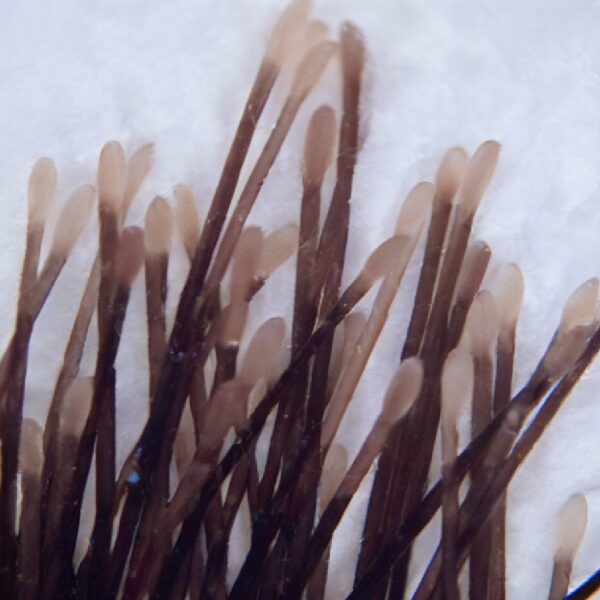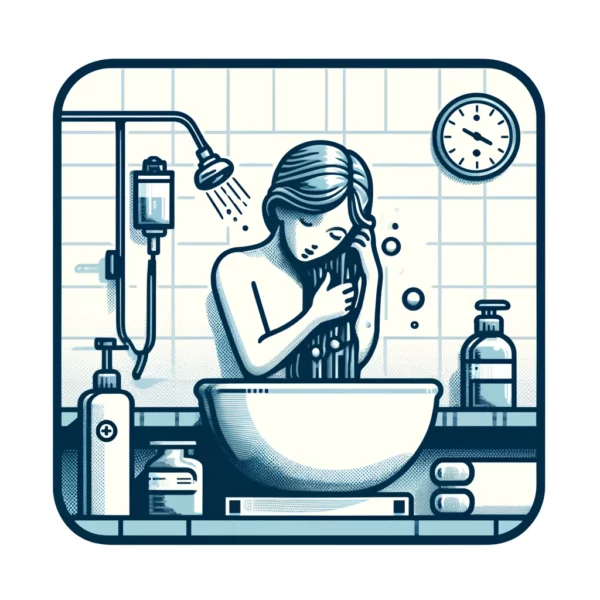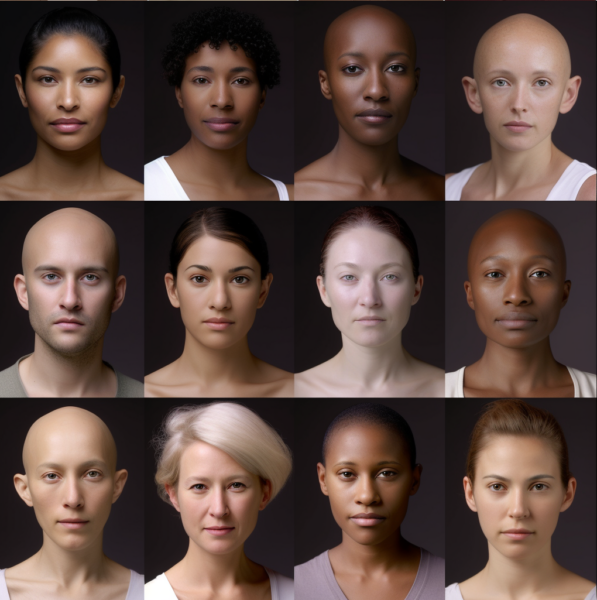The examination of hair shafts and hair bulbs under a microscope is a critical step in diagnosing various hair disorders. A classic method to facilitate this examination is the hair mount test. This test is easy to perform, reliable, and enables the visualization of structural hair shaft abnormalities and disorders of the hair cycle.
In a hair mount test, epilated hair roots are placed on a glass slide. After adding a mounting medium, the hair roots are arranged side by side and covered with a coverslip. The hair mount is then examined using light microscopy. Depending on the stage of the hair cycle, different hair root types are specified. Anagen hair, for instance, has a darkly pigmented bulb with a preserved inner root sheath. Telogen hair, on the other hand, lacks the inner root sheath and has a lightly pigmented to nonpigmented bulb with a distinctive club shape.
Counting the number of anagen hair roots versus the number of telogen hair roots can indicate the presence of conditions such as “telogen effluvium” (a diffuse form of hair loss). Looking at the roots of hairs can also help to diagnose rare hair loss conditions such as “loose anagen syndrome”.
The hair mount test does not just evaluate hair roots; it also provides valuable insights into the condition of the hair shaft. By examining the hair shaft, practitioners can detect fractures, bubbles, irregularities, and twisting. These signs can help diagnose different hair shaft disorders such as monilethrix, trichorrhexis invaginata, trichorrhexis nodosa, pili annulati, and pili torti.
However, technological advancements in dermatology, like trichoscopy, have made the hair mount test less of a necessity in some cases. Many hair shaft abnormalities can be evaluated with magnification several times directly on the scalp. But despite this, the hair mount test remains an indispensable tool in dermatology due to its effectiveness and accuracy.
Looking at specific hair shaft disorders, the hair mount test can reveal a variety of conditions:
Bubble Hair: Often seen in young adults, particularly women, who overuse blow dryers or curling irons. The hair mount shows air bubbles within the hair shaft. Trichorrhexis Nodosa: This condition can be acquired or congenital and typically presents as hair that does not grow long. Overuse of chemicals or repeated trauma from too much brushing can cause the condition. The hair mount test shows brush-like ends in opposition. Monilethrix: This disorder is usually inherited and presents with hair breakage and varying degrees of alopecia. The hair mount test reveals beaded nodes and wide segments alternating with ‘internodes’ constrictions in the hair fiber. Pili Torti: This condition is characterized by hair that does not grow long and breaks easily. The hair mount test reveals closely grouped twists in the hair fiber. Trichorrhexis Invaginata: This condition is inherited and presents with hair that does not grow long. The hair mount test reveals bamboo-like invaginations. Trichothiodystrophy: This inherited disorder presents with brittle hair and is associated with several other conditions like photosensitivity, ichthyosis, and intellectual impairment. The hair mount shows clean horizontal fractures. The hair mount test can also diagnose hair shaft disorders without hair fragility:
Woolly Hair: An inherited or sporadic condition presenting with fine and tightly curled hair. Sometimes the woolly hair is seen in just a patch of scalp, while elsewhere the hair can be straight. The hair mount test typically does not show any characteristic findings. Uncombable Hair Syndrome: An inherited or sporadic condition where hair is unmanageable and difficult to style. The hair mount test reveals a canal-like longitudinal groove along one or two facets of the hair shaft. The hair is usually dry and silvery blonde in color. Pili Annulati: An inherited condition presenting with shiny hair. The hair mount test shows hair shaft with dark and light bands. Hair shaft disorders can present with a variety of clinical features and may have genetic or external causes. Genetic hair shaft abnormalities can be divided into those with increased hair fragility and those without. External factors that cause increased hair fragility include repeated physical injury from excessive grooming, traction from braiding or tight ponytails, and heat from hairdryers, as well as chemical injuries from perming lotions, straighteners, and dyes. The hair mount test provides essential diagnostic information to identify and differentiate these disorders due to the unique insights it provides on hair root types and shaft abnormalities. It’s important to remember that early recognition and treatment of these conditions can prevent further hair damage and loss.
Bibliography
11711645 {11711645:6A96VWKI},{11711645:MA26ZDNK},{11711645:PNDPVITC},{11711645:N7CKNHDU},{11711645:982W6CID} 1 vancouver 50 date asc 163 https://www.keratin.com/wp-content/plugins/zotpress/ %7B%22status%22%3A%22success%22%2C%22updateneeded%22%3Afalse%2C%22instance%22%3Afalse%2C%22meta%22%3A%7B%22request_last%22%3A0%2C%22request_next%22%3A0%2C%22used_cache%22%3Atrue%7D%2C%22data%22%3A%5B%7B%22key%22%3A%22MA26ZDNK%22%2C%22library%22%3A%7B%22id%22%3A11711645%7D%2C%22meta%22%3A%7B%22creatorSummary%22%3A%22Hillmann%20and%20Blume-Peytavi%22%2C%22parsedDate%22%3A%222009-03%22%2C%22numChildren%22%3A0%7D%2C%22bib%22%3A%22%26lt%3Bdiv%20class%3D%26quot%3Bcsl-bib-body%26quot%3B%20style%3D%26quot%3Bline-height%3A%201.35%3B%20%26quot%3B%26gt%3B%5Cn%20%20%26lt%3Bdiv%20class%3D%26quot%3Bcsl-entry%26quot%3B%20style%3D%26quot%3Bclear%3A%20left%3B%20%26quot%3B%26gt%3B%5Cn%20%20%20%20%26lt%3Bdiv%20class%3D%26quot%3Bcsl-left-margin%26quot%3B%20style%3D%26quot%3Bfloat%3A%20left%3B%20padding-right%3A%200.5em%3B%20text-align%3A%20right%3B%20width%3A%201em%3B%26quot%3B%26gt%3B1.%26lt%3B%5C%2Fdiv%26gt%3B%26lt%3Bdiv%20class%3D%26quot%3Bcsl-right-inline%26quot%3B%20style%3D%26quot%3Bmargin%3A%200%20.4em%200%201.5em%3B%26quot%3B%26gt%3BHillmann%20K%2C%20Blume-Peytavi%20U.%20Diagnosis%20of%20hair%20disorders.%20Semin%20Cutan%20Med%20Surg.%202009%20Mar%3B28%281%29%3A33%26%23x2013%3B8.%26lt%3B%5C%2Fdiv%26gt%3B%5Cn%20%20%20%26lt%3B%5C%2Fdiv%26gt%3B%5Cn%26lt%3B%5C%2Fdiv%26gt%3B%22%2C%22data%22%3A%7B%22itemType%22%3A%22journalArticle%22%2C%22title%22%3A%22Diagnosis%20of%20hair%20disorders%22%2C%22creators%22%3A%5B%7B%22creatorType%22%3A%22author%22%2C%22firstName%22%3A%22Kathrin%22%2C%22lastName%22%3A%22Hillmann%22%7D%2C%7B%22creatorType%22%3A%22author%22%2C%22firstName%22%3A%22Ulrike%22%2C%22lastName%22%3A%22Blume-Peytavi%22%7D%5D%2C%22abstractNote%22%3A%22%5Cu4861%5Cu6972%5Cu2064%5Cu6973%5Cu6f72%5Cu6465%5Cu7273%5Cu2069%5Cu6e63%5Cu6c75%5Cu6465%5Cu2068%5Cu6169%5Cu7220%5Cu6c6f%5Cu7373%5Cu2c20%5Cu696e%5Cu6372%5Cu6561%5Cu7365%5Cu6420%5Cu6861%5Cu6972%5Cu2067%5Cu726f%5Cu7774%5Cu682c%5Cu2061%5Cu6e64%5Cu2068%5Cu6169%5Cu7220%5Cu7374%5Cu7275%5Cu6374%5Cu7572%5Cu6520%5Cu6465%5Cu6665%5Cu6374%5Cu7320%5Cu7769%5Cu7468%5Cu2069%5Cu6e63%5Cu7265%5Cu6173%5Cu6564%5Cu2062%5Cu7265%5Cu616b%5Cu6167%5Cu652c%5Cu2061%5Cu7320%5Cu7765%5Cu6c6c%5Cu2061%5Cu7320%5Cu756e%5Cu6163%5Cu6365%5Cu7074%5Cu6162%5Cu6c65%5Cu2063%5Cu6f73%5Cu6d65%5Cu7469%5Cu6320%5Cu6170%5Cu7065%5Cu6172%5Cu616e%5Cu6365%5Cu2c20%5Cu7375%5Cu6368%5Cu2061%5Cu7320%5Cu7265%5Cu6475%5Cu6365%5Cu6420%5Cu7368%5Cu696e%5Cu652c%5Cu2073%5Cu7472%5Cu656e%5Cu6774%5Cu682c%5Cu2063%5Cu7572%5Cu6c69%5Cu6e65%5Cu7373%5Cu2c20%5Cu616e%5Cu6420%5Cu656c%5Cu6173%5Cu7469%5Cu6369%5Cu7479%5Cu2e20%5Cu4974%5Cu2069%5Cu7320%5Cu7468%5Cu6520%5Cu7461%5Cu736b%5Cu206f%5Cu6620%5Cu7468%5Cu6520%5Cu6465%5Cu726d%5Cu6174%5Cu6f6c%5Cu6f67%5Cu6973%5Cu7420%5Cu746f%5Cu2063%5Cu686f%5Cu6f73%5Cu6520%5Cu7468%5Cu6520%5Cu7269%5Cu6768%5Cu7420%5Cu6469%5Cu6167%5Cu6e6f%5Cu7374%5Cu6963%5Cu2074%5Cu6f6f%5Cu6c20%5Cu6465%5Cu7065%5Cu6e64%5Cu696e%5Cu6720%5Cu6f6e%5Cu2074%5Cu6865%5Cu2073%5Cu7573%5Cu7065%5Cu6374%5Cu6564%5Cu2063%5Cu6c69%5Cu6e69%5Cu6361%5Cu6c20%5Cu6469%5Cu6167%5Cu6e6f%5Cu7369%5Cu732e%5Cu204d%5Cu6f72%5Cu656f%5Cu7665%5Cu722c%5Cu2063%5Cu6572%5Cu7461%5Cu696e%5Cu2074%5Cu6f6f%5Cu6c73%5Cu2061%5Cu7265%5Cu2062%5Cu6573%5Cu7420%5Cu7375%5Cu6974%5Cu6564%5Cu2066%5Cu6f72%5Cu2064%5Cu6961%5Cu676e%5Cu6f73%5Cu6973%5Cu2069%5Cu6e20%5Cu7072%5Cu6976%5Cu6174%5Cu6520%5Cu7072%5Cu6163%5Cu7469%5Cu6365%5Cu2c20%5Cu7768%5Cu6572%5Cu6561%5Cu7320%5Cu6f74%5Cu6865%5Cu7273%5Cu2063%5Cu616e%5Cu206f%5Cu6e6c%5Cu7920%5Cu6265%5Cu2075%5Cu7365%5Cu6420%5Cu746f%5Cu206d%5Cu6f6e%5Cu6974%5Cu6f72%5Cu2068%5Cu6169%5Cu7220%5Cu6772%5Cu6f77%5Cu7468%5Cu2075%5Cu6e64%5Cu6572%5Cu2074%5Cu7265%5Cu6174%5Cu6d65%5Cu6e74%5Cu2069%5Cu6e20%5Cu636c%5Cu696e%5Cu6963%5Cu616c%5Cu2073%5Cu7475%5Cu6469%5Cu6573%5Cu2e20%5Cu5468%5Cu6520%5Cu7465%5Cu6368%5Cu6e69%5Cu7175%5Cu6573%5Cu2063%5Cu616e%5Cu2062%5Cu6520%5Cu636c%5Cu6173%5Cu7369%5Cu6669%5Cu6564%5Cu2061%5Cu7320%5Cu6569%5Cu7468%5Cu6572%5Cu2069%5Cu6e76%5Cu6173%5Cu6976%5Cu6520%5Cu2865%5Cu672c%5Cu2062%5Cu696f%5Cu7073%5Cu6965%5Cu7320%5Cu696e%5Cu2073%5Cu6361%5Cu7272%5Cu696e%5Cu6720%5Cu616c%5Cu6f70%5Cu6563%5Cu6961%5Cu292c%5Cu2073%5Cu656d%5Cu692d%5Cu696e%5Cu7661%5Cu7369%5Cu7665%5Cu2028%5Cu7472%5Cu6963%5Cu686f%5Cu6772%5Cu616d%5Cu2c20%5Cu756e%5Cu6974%5Cu2061%5Cu7265%5Cu6120%5Cu7472%5Cu6963%5Cu686f%5Cu6772%5Cu616d%5Cu292c%5Cu206f%5Cu7220%5Cu6e6f%5Cu6e69%5Cu6e76%5Cu6173%5Cu6976%5Cu6520%5Cu2865%5Cu672c%5Cu2067%5Cu6c6f%5Cu6261%5Cu6c20%5Cu6861%5Cu6972%5Cu2063%5Cu6f75%5Cu6e74%5Cu732c%5Cu2070%5Cu686f%5Cu746f%5Cu7472%5Cu6963%5Cu686f%5Cu6772%5Cu616d%5Cu2c20%5Cu656c%5Cu6563%5Cu7472%5Cu6f6e%5Cu206d%5Cu6963%5Cu726f%5Cu7363%5Cu6f70%5Cu792c%5Cu206c%5Cu6173%5Cu6572%5Cu2073%5Cu6361%5Cu6e6e%5Cu696e%5Cu6720%5Cu6d69%5Cu6372%5Cu6f73%5Cu636f%5Cu7079%5Cu2920%5Cu6d65%5Cu7468%5Cu6f64%5Cu732e%5Cu2046%5Cu7572%5Cu7468%5Cu6572%5Cu2c20%5Cu6f6e%5Cu6520%5Cu6d75%5Cu7374%5Cu2064%5Cu6966%5Cu6665%5Cu7265%5Cu6e74%5Cu6961%5Cu7465%5Cu2062%5Cu6574%5Cu7765%5Cu656e%5Cu2073%5Cu7562%5Cu6a65%5Cu6374%5Cu6976%5Cu6520%5Cu616e%5Cu6420%5Cu6f62%5Cu6a65%5Cu6374%5Cu6976%5Cu6520%5Cu7465%5Cu6368%5Cu6e69%5Cu7175%5Cu6573%5Cu2e20%5Cu466f%5Cu7220%5Cu7468%5Cu6520%5Cu7072%5Cu6163%5Cu7469%5Cu6369%5Cu6e67%5Cu2064%5Cu6572%5Cu6d61%5Cu746f%5Cu6c6f%5Cu6769%5Cu7374%5Cu2c20%5Cu626f%5Cu6479%5Cu2061%5Cu6e64%5Cu2073%5Cu6361%5Cu6c70%5Cu2068%5Cu6169%5Cu7220%5Cu6469%5Cu7374%5Cu7269%5Cu6275%5Cu7469%5Cu6f6e%5Cu2062%5Cu7920%5Cu7573%5Cu6520%5Cu6f66%5Cu2064%5Cu6966%5Cu6665%5Cu7265%5Cu6e74%5Cu2067%5Cu7261%5Cu6469%5Cu6e67%5Cu2073%5Cu7973%5Cu7465%5Cu6d73%5Cu2c20%5Cu7468%5Cu6520%5Cu6861%5Cu6972%5Cu2070%5Cu756c%5Cu6c20%5Cu7465%5Cu7374%5Cu2c20%5Cu616e%5Cu6420%5Cu6465%5Cu726d%5Cu6f73%5Cu636f%5Cu7079%5Cu2062%5Cu656c%5Cu6f6e%5Cu6720%5Cu696e%5Cu2074%5Cu6865%5Cu2063%5Cu6174%5Cu6567%5Cu6f72%5Cu7920%5Cu6f66%5Cu2062%5Cu6173%5Cu6963%5Cu2064%5Cu6961%5Cu676e%5Cu6f73%5Cu7469%5Cu6320%5Cu746f%5Cu6f6c%5Cu732e%5Cu2042%5Cu6173%5Cu6963%5Cu2074%5Cu6563%5Cu686e%5Cu6971%5Cu7565%5Cu7320%5Cu6d61%5Cu7920%5Cu6265%5Cu2065%5Cu7874%5Cu656e%5Cu6465%5Cu6420%5Cu6279%5Cu2063%5Cu6f6d%5Cu7075%5Cu7465%5Cu722d%5Cu6173%5Cu7369%5Cu7374%5Cu6564%5Cu2070%5Cu686f%5Cu746f%5Cu7472%5Cu6963%5Cu686f%5Cu6772%5Cu616d%5Cu2061%5Cu6e64%5Cu2c20%5Cu696e%5Cu2073%5Cu656c%5Cu6563%5Cu7465%5Cu6420%5Cu6361%5Cu7365%5Cu732c%5Cu2062%5Cu7920%5Cu7573%5Cu6520%5Cu6f66%5Cu2074%5Cu6865%5Cu2074%5Cu7269%5Cu6368%5Cu6f67%5Cu7261%5Cu6d20%5Cu616e%5Cu642f%5Cu6f72%5Cu2073%5Cu6361%5Cu6c70%5Cu2062%5Cu696f%5Cu7073%5Cu6965%5Cu732e%5Cu2046%5Cu6f72%5Cu2072%5Cu6573%5Cu6561%5Cu7263%5Cu6820%5Cu7075%5Cu7270%5Cu6f73%5Cu6573%5Cu206f%5Cu7074%5Cu6963%5Cu616c%5Cu2063%5Cu6f68%5Cu6572%5Cu656e%5Cu7420%5Cu746f%5Cu6d6f%5Cu6772%5Cu6170%5Cu6879%5Cu2c20%5Cu656c%5Cu6563%5Cu7472%5Cu6f6e%5Cu206d%5Cu6963%5Cu726f%5Cu7363%5Cu6f70%5Cu792c%5Cu2062%5Cu696f%5Cu6368%5Cu656d%5Cu6963%5Cu616c%5Cu206d%5Cu6574%5Cu686f%5Cu6473%5Cu2c20%5Cu6174%5Cu6f6d%5Cu6963%5Cu2066%5Cu6f72%5Cu6365%5Cu206d%5Cu6963%5Cu726f%5Cu7363%5Cu6f70%5Cu792c%5Cu2061%5Cu6e64%5Cu2063%5Cu6f6e%5Cu666f%5Cu6361%5Cu6c20%5Cu6c61%5Cu7365%5Cu7220%5Cu7363%5Cu616e%5Cu6e69%5Cu6e67%5Cu206d%5Cu6963%5Cu726f%5Cu7363%5Cu6f70%5Cu7920%5Cu6172%5Cu6520%5Cu6f70%5Cu7469%5Cu6f6e%5Cu616c%5Cu2074%5Cu6f6f%5Cu6c73%5Cu2e20%5Cu466f%5Cu7220%5Cu636c%5Cu696e%5Cu6963%5Cu616c%5Cu2073%5Cu7475%5Cu6469%5Cu6573%5Cu2067%5Cu6c6f%5Cu6261%5Cu6c20%5Cu7068%5Cu6f74%5Cu6f67%5Cu7261%5Cu7068%5Cu7320%5Cu2867%5Cu6c6f%5Cu6261%5Cu6c20%5Cu6578%5Cu7065%5Cu7274%5Cu2070%5Cu616e%5Cu656c%5Cu292c%5Cu2068%5Cu6169%5Cu7220%5Cu7765%5Cu6967%5Cu6869%5Cu6e67%5Cu2c20%5Cu7068%5Cu6f74%5Cu6f74%5Cu7269%5Cu6368%5Cu6f67%5Cu7261%5Cu6d2c%5Cu2061%5Cu6e64%5Cu2064%5Cu6966%5Cu6665%5Cu7265%5Cu6e74%5Cu2063%5Cu6c69%5Cu6e69%5Cu6361%5Cu6c20%5Cu7363%5Cu6f72%5Cu696e%5Cu6720%5Cu7379%5Cu7374%5Cu656d%5Cu7320%5Cu6861%5Cu7665%5Cu2070%5Cu726f%5Cu7665%5Cu6e20%5Cu746f%5Cu2062%5Cu6520%5Cu6f62%5Cu6a65%5Cu6374%5Cu6976%5Cu6520%5Cu746f%5Cu6f6c%5Cu7320%5Cu666f%5Cu7220%5Cu646f%5Cu6375%5Cu6d65%5Cu6e74%5Cu6174%5Cu696f%5Cu6e20%5Cu616e%5Cu6420%5Cu6576%5Cu616c%5Cu7561%5Cu7469%5Cu6f6e%5Cu206f%5Cu6620%5Cu6861%5Cu6972%5Cu2067%5Cu726f%5Cu7774%5Cu6820%5Cu616e%5Cu6420%5Cu6861%5Cu6972%5Cu2071%5Cu7561%5Cu6c69%5Cu7479%3F%22%2C%22date%22%3A%222009-03%22%2C%22language%22%3A%22eng%22%2C%22DOI%22%3A%2210.1016%5C%2Fj.sder.2008.12.005%22%2C%22ISSN%22%3A%221558-0768%22%2C%22url%22%3A%22%22%2C%22collections%22%3A%5B%22QPFHQW2X%22%5D%2C%22dateModified%22%3A%222023-05-21T16%3A41%3A16Z%22%7D%7D%2C%7B%22key%22%3A%226A96VWKI%22%2C%22library%22%3A%7B%22id%22%3A11711645%7D%2C%22meta%22%3A%7B%22creatorSummary%22%3A%22Mirmirani%20et%20al.%22%2C%22parsedDate%22%3A%222011-01%22%2C%22numChildren%22%3A0%7D%2C%22bib%22%3A%22%26lt%3Bdiv%20class%3D%26quot%3Bcsl-bib-body%26quot%3B%20style%3D%26quot%3Bline-height%3A%201.35%3B%20%26quot%3B%26gt%3B%5Cn%20%20%26lt%3Bdiv%20class%3D%26quot%3Bcsl-entry%26quot%3B%20style%3D%26quot%3Bclear%3A%20left%3B%20%26quot%3B%26gt%3B%5Cn%20%20%20%20%26lt%3Bdiv%20class%3D%26quot%3Bcsl-left-margin%26quot%3B%20style%3D%26quot%3Bfloat%3A%20left%3B%20padding-right%3A%200.5em%3B%20text-align%3A%20right%3B%20width%3A%201em%3B%26quot%3B%26gt%3B1.%26lt%3B%5C%2Fdiv%26gt%3B%26lt%3Bdiv%20class%3D%26quot%3Bcsl-right-inline%26quot%3B%20style%3D%26quot%3Bmargin%3A%200%20.4em%200%201.5em%3B%26quot%3B%26gt%3BMirmirani%20P%2C%20Huang%20KP%2C%20Price%20VH.%20A%20practical%2C%20algorithmic%20approach%20to%20diagnosing%20hair%20shaft%20disorders.%20Int%20J%20Dermatol.%202011%20Jan%3B50%281%29%3A1%26%23x2013%3B12.%26lt%3B%5C%2Fdiv%26gt%3B%5Cn%20%20%20%26lt%3B%5C%2Fdiv%26gt%3B%5Cn%26lt%3B%5C%2Fdiv%26gt%3B%22%2C%22data%22%3A%7B%22itemType%22%3A%22journalArticle%22%2C%22title%22%3A%22A%20practical%2C%20algorithmic%20approach%20to%20diagnosing%20hair%20shaft%20disorders%22%2C%22creators%22%3A%5B%7B%22creatorType%22%3A%22author%22%2C%22firstName%22%3A%22Paradi%22%2C%22lastName%22%3A%22Mirmirani%22%7D%2C%7B%22creatorType%22%3A%22author%22%2C%22firstName%22%3A%22Kathie%20P.%22%2C%22lastName%22%3A%22Huang%22%7D%2C%7B%22creatorType%22%3A%22author%22%2C%22firstName%22%3A%22Vera%20H.%22%2C%22lastName%22%3A%22Price%22%7D%5D%2C%22abstractNote%22%3A%22%5Cu5468%5Cu6520%5Cu6861%5Cu6972%5Cu2073%5Cu6861%5Cu6674%5Cu2069%5Cu7320%5Cu6120%5Cu756e%5Cu6971%5Cu7565%5Cu2073%5Cu7472%5Cu7563%5Cu7475%5Cu7265%5Cu2063%5Cu6f6d%5Cu706f%5Cu7365%5Cu6420%5Cu6f66%5Cu2061%5Cu6e20%5Cu696e%5Cu6e65%5Cu7220%5Cu636f%5Cu7274%5Cu6578%5Cu2061%5Cu6e64%5Cu2061%5Cu2070%5Cu726f%5Cu7465%5Cu6374%5Cu6976%5Cu6520%5Cu6f75%5Cu7465%5Cu7220%5Cu6375%5Cu7469%5Cu636c%5Cu652e%5Cu2041%5Cu6e79%5Cu2064%5Cu6566%5Cu6563%5Cu7473%5Cu2069%5Cu6e20%5Cu7468%5Cu6973%5Cu206e%5Cu6f72%5Cu6d61%5Cu6c20%5Cu7374%5Cu7275%5Cu6374%5Cu7572%5Cu6520%5Cu6475%5Cu6520%5Cu746f%5Cu2067%5Cu656e%5Cu6574%5Cu6963%5Cu7320%5Cu6f72%5Cu2074%5Cu6865%5Cu2065%5Cu6e76%5Cu6972%5Cu6f6e%5Cu6d65%5Cu6e74%5Cu2063%5Cu616e%5Cu206c%5Cu6561%5Cu6420%5Cu746f%5Cu2076%5Cu6172%5Cu6961%5Cu7469%5Cu6f6e%5Cu7320%5Cu696e%5Cu2070%5Cu6879%5Cu7369%5Cu6361%5Cu6c20%5Cu7072%5Cu6f70%5Cu6572%5Cu7469%5Cu6573%5Cu2e20%5Cu5468%5Cu7573%5Cu206f%5Cu6e65%5Cu2073%5Cu686f%5Cu756c%5Cu6420%5Cu7375%5Cu7370%5Cu6563%5Cu7420%5Cu6120%5Cu6861%5Cu6972%5Cu2073%5Cu6861%5Cu6674%5Cu2064%5Cu6973%5Cu6f72%5Cu6465%5Cu7220%5Cu6966%5Cu2061%5Cu2070%5Cu6174%5Cu6965%5Cu6e74%5Cu2070%5Cu7265%5Cu7365%5Cu6e74%5Cu7320%5Cu7769%5Cu7468%5Cu2061%5Cu6e20%5Cu6162%5Cu6e6f%5Cu726d%5Cu616c%5Cu6974%5Cu7920%5Cu6f72%5Cu2063%5Cu6861%5Cu6e67%5Cu6520%5Cu696e%5Cu2068%5Cu6169%5Cu7220%5Cu7465%5Cu7874%5Cu7572%5Cu652c%5Cu2061%5Cu7070%5Cu6561%5Cu7261%5Cu6e63%5Cu652c%5Cu206d%5Cu616e%5Cu6167%5Cu6561%5Cu6269%5Cu6c69%5Cu7479%5Cu206f%5Cu7220%5Cu6162%5Cu696c%5Cu6974%5Cu7920%5Cu746f%5Cu2067%5Cu726f%5Cu7720%5Cu6861%5Cu6972%5Cu206c%5Cu6f6e%5Cu672e%5Cu2041%5Cu206b%5Cu6579%5Cu2066%5Cu6561%5Cu7475%5Cu7265%5Cu206f%5Cu6620%5Cu7468%5Cu6520%5Cu636c%5Cu696e%5Cu6963%5Cu616c%5Cu2065%5Cu7661%5Cu6c75%5Cu6174%5Cu696f%5Cu6e20%5Cu6973%5Cu2074%5Cu6f20%5Cu6465%5Cu7465%5Cu726d%5Cu696e%5Cu6520%5Cu7768%5Cu6574%5Cu6865%5Cu7220%5Cu7468%5Cu6572%5Cu6520%5Cu6973%5Cu2068%5Cu6169%5Cu7220%5Cu6272%5Cu6561%5Cu6b61%5Cu6765%5Cu2028%5Cu696e%5Cu6372%5Cu6561%5Cu7365%5Cu6420%5Cu6672%5Cu6167%5Cu696c%5Cu6974%5Cu7929%5Cu2062%5Cu7920%5Cu6c6f%5Cu6f6b%5Cu696e%5Cu6720%5Cu666f%5Cu7220%5Cu6272%5Cu6f6b%5Cu656e%5Cu2068%5Cu6169%5Cu7273%5Cu2061%5Cu6e64%5Cu2070%5Cu6572%5Cu666f%5Cu726d%5Cu696e%5Cu6720%5Cu6120%5Cu7475%5Cu6720%5Cu7465%5Cu7374%5Cu2e20%5Cu4f6e%5Cu6365%5Cu2074%5Cu6869%5Cu7320%5Cu6465%5Cu7465%5Cu726d%5Cu696e%5Cu6174%5Cu696f%5Cu6e20%5Cu6973%5Cu206d%5Cu6164%5Cu652c%5Cu2061%5Cu6e20%5Cu616c%5Cu676f%5Cu7269%5Cu7468%5Cu6d69%5Cu6320%5Cu6170%5Cu7072%5Cu6f61%5Cu6368%5Cu2063%5Cu616e%5Cu2062%5Cu6520%5Cu7573%5Cu6564%5Cu2074%5Cu6f20%5Cu6e61%5Cu7272%5Cu6f77%5Cu2074%5Cu6865%5Cu2064%5Cu6966%5Cu6665%5Cu7265%5Cu6e74%5Cu6961%5Cu6c20%5Cu6469%5Cu6167%5Cu6e6f%5Cu7369%5Cu733a%5Cu2068%5Cu6169%5Cu7220%5Cu7368%5Cu6166%5Cu7420%5Cu6469%5Cu736f%5Cu7264%5Cu6572%5Cu7320%5Cu7769%5Cu7468%5Cu2061%5Cu6e64%5Cu2077%5Cu6974%5Cu686f%5Cu7574%5Cu2066%5Cu7261%5Cu6769%5Cu6c69%5Cu7479%5Cu2e20%5Cu4120%5Cu6861%5Cu6972%5Cu206d%5Cu6f75%5Cu6e74%5Cu2061%5Cu6c6f%5Cu6e67%5Cu2077%5Cu6974%5Cu6820%5Cu6f74%5Cu6865%5Cu7220%5Cu6469%5Cu7265%5Cu6374%5Cu6564%5Cu2071%5Cu7565%5Cu7374%5Cu696f%5Cu6e73%5Cu2061%5Cu6e64%5Cu2065%5Cu7861%5Cu6d69%5Cu6e61%5Cu7469%5Cu6f6e%5Cu2077%5Cu696c%5Cu6c20%5Cu616c%5Cu6d6f%5Cu7374%5Cu2061%5Cu6c77%5Cu6179%5Cu7320%5Cu616c%5Cu6c6f%5Cu7720%5Cu7468%5Cu6520%5Cu636c%5Cu696e%5Cu6963%5Cu6961%5Cu6e20%5Cu746f%5Cu206d%5Cu616b%5Cu6520%5Cu616e%5Cu2069%5Cu6e2d%5Cu6f66%5Cu6669%5Cu6365%5Cu2064%5Cu6961%5Cu676e%5Cu6f73%5Cu6973%5Cu2e20%5Cu436f%5Cu6d6d%5Cu6f6e%5Cu2063%5Cu6173%5Cu6520%5Cu7363%5Cu656e%5Cu6172%5Cu696f%5Cu732c%5Cu2070%5Cu686f%5Cu746f%5Cu6772%5Cu6170%5Cu6873%5Cu2c20%5Cu616e%5Cu6420%5Cu7072%5Cu6163%5Cu7469%5Cu6361%5Cu6c20%5Cu7469%5Cu7073%5Cu2061%5Cu7265%5Cu2070%5Cu726f%5Cu7669%5Cu6465%5Cu6420%5Cu746f%5Cu2069%5Cu6c6c%5Cu7573%5Cu7472%5Cu6174%5Cu6520%5Cu7468%5Cu6520%5Cu7573%5Cu6520%5Cu6f66%5Cu2074%5Cu6869%5Cu7320%5Cu616c%5Cu676f%5Cu7269%5Cu7468%5Cu6d69%5Cu6320%5Cu6170%5Cu7072%5Cu6f61%5Cu6368%5Cu2069%5Cu6e20%5Cu7468%5Cu6520%5Cu6469%5Cu6167%5Cu6e6f%5Cu7369%5Cu7320%5Cu6f66%5Cu2068%5Cu6169%5Cu7220%5Cu7368%5Cu6166%5Cu7420%5Cu6469%5Cu736f%5Cu7264%5Cu6572%5Cu732e%5Cu2057%5Cu6520%5Cu6861%5Cu7665%5Cu2061%5Cu6c73%5Cu6f20%5Cu696e%5Cu636c%5Cu7564%5Cu6564%5Cu2061%5Cu2073%5Cu756d%5Cu6d61%5Cu7279%5Cu206f%5Cu6620%5Cu7468%5Cu6520%5Cu6d6f%5Cu6c65%5Cu6375%5Cu6c61%5Cu7220%5Cu6465%5Cu6665%5Cu6374%5Cu7320%5Cu7768%5Cu6572%5Cu6520%5Cu6b6e%5Cu6f77%5Cu6e2c%5Cu2077%5Cu6869%5Cu6368%5Cu2063%5Cu616e%5Cu2062%5Cu6520%5Cu6865%5Cu6c70%5Cu6675%5Cu6c20%5Cu696e%5Cu2070%5Cu726f%5Cu7669%5Cu6469%5Cu6e67%5Cu2061%5Cu2063%5Cu6f72%5Cu7265%5Cu6c61%5Cu7469%5Cu6f6e%5Cu2077%5Cu6974%5Cu6820%5Cu636c%5Cu696e%5Cu6963%5Cu616c%5Cu2066%5Cu696e%5Cu6469%5Cu6e67%5Cu732c%5Cu2069%5Cu6e20%5Cu636f%5Cu756e%5Cu7365%5Cu6c69%5Cu6e67%5Cu2070%5Cu6174%5Cu6965%5Cu6e74%5Cu732c%5Cu2061%5Cu6e64%5Cu2070%5Cu6f74%5Cu656e%5Cu7469%5Cu616c%5Cu6c79%5Cu206f%5Cu6666%5Cu6572%5Cu696e%5Cu6720%5Cu7472%5Cu6561%5Cu746d%5Cu656e%5Cu7420%5Cu6f70%5Cu7469%5Cu6f6e%5Cu732e%22%2C%22date%22%3A%222011-01%22%2C%22language%22%3A%22eng%22%2C%22DOI%22%3A%2210.1111%5C%2Fj.1365-4632.2010.04768.x%22%2C%22ISSN%22%3A%221365-4632%22%2C%22url%22%3A%22%22%2C%22collections%22%3A%5B%22369UWN25%22%5D%2C%22dateModified%22%3A%222023-05-21T15%3A45%3A17Z%22%7D%7D%2C%7B%22key%22%3A%22N7CKNHDU%22%2C%22library%22%3A%7B%22id%22%3A11711645%7D%2C%22meta%22%3A%7B%22creatorSummary%22%3A%22Jackson%20and%20Price%22%2C%22parsedDate%22%3A%222013-01%22%2C%22numChildren%22%3A0%7D%2C%22bib%22%3A%22%26lt%3Bdiv%20class%3D%26quot%3Bcsl-bib-body%26quot%3B%20style%3D%26quot%3Bline-height%3A%201.35%3B%20%26quot%3B%26gt%3B%5Cn%20%20%26lt%3Bdiv%20class%3D%26quot%3Bcsl-entry%26quot%3B%20style%3D%26quot%3Bclear%3A%20left%3B%20%26quot%3B%26gt%3B%5Cn%20%20%20%20%26lt%3Bdiv%20class%3D%26quot%3Bcsl-left-margin%26quot%3B%20style%3D%26quot%3Bfloat%3A%20left%3B%20padding-right%3A%200.5em%3B%20text-align%3A%20right%3B%20width%3A%201em%3B%26quot%3B%26gt%3B1.%26lt%3B%5C%2Fdiv%26gt%3B%26lt%3Bdiv%20class%3D%26quot%3Bcsl-right-inline%26quot%3B%20style%3D%26quot%3Bmargin%3A%200%20.4em%200%201.5em%3B%26quot%3B%26gt%3BJackson%20AJ%2C%20Price%20VH.%20How%20to%20diagnose%20hair%20loss.%20Dermatol%20Clin.%202013%20Jan%3B31%281%29%3A21%26%23x2013%3B8.%26lt%3B%5C%2Fdiv%26gt%3B%5Cn%20%20%20%26lt%3B%5C%2Fdiv%26gt%3B%5Cn%26lt%3B%5C%2Fdiv%26gt%3B%22%2C%22data%22%3A%7B%22itemType%22%3A%22journalArticle%22%2C%22title%22%3A%22How%20to%20diagnose%20hair%20loss%22%2C%22creators%22%3A%5B%7B%22creatorType%22%3A%22author%22%2C%22firstName%22%3A%22Adrianna%20J.%22%2C%22lastName%22%3A%22Jackson%22%7D%2C%7B%22creatorType%22%3A%22author%22%2C%22firstName%22%3A%22Vera%20H.%22%2C%22lastName%22%3A%22Price%22%7D%5D%2C%22abstractNote%22%3A%22%5Cu5468%5Cu6973%5Cu2072%5Cu6576%5Cu6965%5Cu7720%5Cu7072%5Cu6573%5Cu656e%5Cu7473%5Cu2061%5Cu2073%5Cu7973%5Cu7465%5Cu6d61%5Cu7469%5Cu6320%5Cu6170%5Cu7072%5Cu6f61%5Cu6368%5Cu2074%5Cu6f20%5Cu7468%5Cu6520%5Cu6469%5Cu6167%5Cu6e6f%5Cu7369%5Cu7320%5Cu6f66%5Cu2068%5Cu6169%5Cu7220%5Cu6c6f%5Cu7373%5Cu2e20%5Cu416e%5Cu2061%5Cu6363%5Cu7572%5Cu6174%5Cu6520%5Cu6469%5Cu6167%5Cu6e6f%5Cu7369%5Cu7320%5Cu6973%5Cu2062%5Cu6173%5Cu6564%5Cu206f%5Cu6e20%5Cu6869%5Cu7374%5Cu6f72%5Cu792c%5Cu2063%5Cu6c69%5Cu6e69%5Cu6361%5Cu6c20%5Cu6578%5Cu616d%5Cu696e%5Cu6174%5Cu696f%5Cu6e2c%5Cu206c%5Cu6162%5Cu6f72%5Cu6174%5Cu6f72%5Cu7920%5Cu7465%5Cu7374%5Cu732c%5Cu2061%5Cu6e64%5Cu2073%5Cu6361%5Cu6c70%5Cu2062%5Cu696f%5Cu7073%5Cu792e%5Cu2057%5Cu6865%5Cu7468%5Cu6572%5Cu2074%5Cu6865%5Cu2068%5Cu6169%5Cu7220%5Cu6c6f%5Cu7373%5Cu2069%5Cu7320%5Cu6120%5Cu6369%5Cu6361%5Cu7472%5Cu6963%5Cu6961%5Cu6c20%5Cu6f72%5Cu206e%5Cu6f6e%5Cu6369%5Cu6361%5Cu7472%5Cu6963%5Cu6961%5Cu6c20%5Cu616c%5Cu6f70%5Cu6563%5Cu6961%5Cu2067%5Cu7569%5Cu6465%5Cu7320%5Cu6f6e%5Cu6527%5Cu7320%5Cu6869%5Cu7374%5Cu6f72%5Cu7920%5Cu7461%5Cu6b69%5Cu6e67%5Cu2e20%5Cu4166%5Cu7465%5Cu7220%5Cu6173%5Cu7365%5Cu7373%5Cu696e%5Cu6720%5Cu7468%5Cu6520%5Cu7061%5Cu7469%5Cu656e%5Cu7427%5Cu7320%5Cu676c%5Cu6f62%5Cu616c%5Cu2061%5Cu7070%5Cu6561%5Cu7261%5Cu6e63%5Cu652c%5Cu2074%5Cu6865%5Cu2068%5Cu6169%5Cu7220%5Cu616e%5Cu6420%5Cu7363%5Cu616c%5Cu7020%5Cu6172%5Cu6520%5Cu6576%5Cu616c%5Cu7561%5Cu7465%5Cu642c%5Cu2061%5Cu6964%5Cu6564%5Cu2062%5Cu7920%5Cu6120%5Cu6861%5Cu6972%5Cu2070%5Cu756c%5Cu6c2c%5Cu2068%5Cu6169%5Cu7220%5Cu7475%5Cu672c%5Cu2048%5Cu6169%5Cu7220%5Cu4361%5Cu7264%5Cu2c20%5Cu616e%5Cu6420%5Cu6861%5Cu6972%5Cu206d%5Cu6f75%5Cu6e74%5Cu2e20%5Cu5363%5Cu616c%5Cu7020%5Cu6269%5Cu6f70%5Cu7369%5Cu6573%5Cu2063%5Cu616e%5Cu2063%5Cu6f6e%5Cu6669%5Cu726d%5Cu2061%5Cu2064%5Cu6961%5Cu676e%5Cu6f73%5Cu6973%5Cu2061%5Cu6e64%5Cu2061%5Cu7265%5Cu2065%5Cu7373%5Cu656e%5Cu7469%5Cu616c%5Cu2069%5Cu6e20%5Cu616c%5Cu6c20%5Cu6361%5Cu7365%5Cu7320%5Cu6f66%5Cu2063%5Cu6963%5Cu6174%5Cu7269%5Cu6369%5Cu616c%5Cu2061%5Cu6c6f%5Cu7065%5Cu6369%5Cu612e%5Cu2049%5Cu6e20%5Cu616c%5Cu6c20%5Cu7061%5Cu7469%5Cu656e%5Cu7473%5Cu2077%5Cu6974%5Cu6820%5Cu6861%5Cu6972%5Cu206c%5Cu6f73%5Cu7320%5Cu6120%5Cu636f%5Cu6d70%5Cu6c65%5Cu7465%5Cu2062%5Cu6c6f%5Cu6f64%5Cu2063%5Cu6f75%5Cu6e74%5Cu2c20%5Cu6665%5Cu7272%5Cu6974%5Cu696e%5Cu2c20%5Cu7468%5Cu7972%5Cu6f69%5Cu6420%5Cu7374%5Cu696d%5Cu756c%5Cu6174%5Cu696e%5Cu6720%5Cu686f%5Cu726d%5Cu6f6e%5Cu652c%5Cu2061%5Cu6e64%5Cu2076%5Cu6974%5Cu616d%5Cu696e%5Cu2044%5Cu2032%5Cu354f%5Cu4820%5Cu7368%5Cu6f75%5Cu6c64%5Cu2062%5Cu6520%5Cu6f72%5Cu6465%5Cu7265%5Cu642e%22%2C%22date%22%3A%222013-01%22%2C%22language%22%3A%22eng%22%2C%22DOI%22%3A%2210.1016%5C%2Fj.det.2012.08.007%22%2C%22ISSN%22%3A%221558-0520%22%2C%22url%22%3A%22%22%2C%22collections%22%3A%5B%22QPFHQW2X%22%5D%2C%22dateModified%22%3A%222023-05-21T16%3A41%3A29Z%22%7D%7D%2C%7B%22key%22%3A%22982W6CID%22%2C%22library%22%3A%7B%22id%22%3A11711645%7D%2C%22meta%22%3A%7B%22creatorSummary%22%3A%22Price%22%2C%22parsedDate%22%3A%222013-12%22%2C%22numChildren%22%3A0%7D%2C%22bib%22%3A%22%26lt%3Bdiv%20class%3D%26quot%3Bcsl-bib-body%26quot%3B%20style%3D%26quot%3Bline-height%3A%201.35%3B%20%26quot%3B%26gt%3B%5Cn%20%20%26lt%3Bdiv%20class%3D%26quot%3Bcsl-entry%26quot%3B%20style%3D%26quot%3Bclear%3A%20left%3B%20%26quot%3B%26gt%3B%5Cn%20%20%20%20%26lt%3Bdiv%20class%3D%26quot%3Bcsl-left-margin%26quot%3B%20style%3D%26quot%3Bfloat%3A%20left%3B%20padding-right%3A%200.5em%3B%20text-align%3A%20right%3B%20width%3A%201em%3B%26quot%3B%26gt%3B1.%26lt%3B%5C%2Fdiv%26gt%3B%26lt%3Bdiv%20class%3D%26quot%3Bcsl-right-inline%26quot%3B%20style%3D%26quot%3Bmargin%3A%200%20.4em%200%201.5em%3B%26quot%3B%26gt%3BPrice%20VH.%20What%20looks%20like%20alopecia%20areata%20is%20not%20always%20alopecia%20areata.%20J%20Investig%20Dermatol%20Symp%20Proc.%202013%20Dec%3B16%281%29%3AS63-64.%26lt%3B%5C%2Fdiv%26gt%3B%5Cn%20%20%20%26lt%3B%5C%2Fdiv%26gt%3B%5Cn%26lt%3B%5C%2Fdiv%26gt%3B%22%2C%22data%22%3A%7B%22itemType%22%3A%22journalArticle%22%2C%22title%22%3A%22What%20looks%20like%20alopecia%20areata%20is%20not%20always%20alopecia%20areata%22%2C%22creators%22%3A%5B%7B%22creatorType%22%3A%22author%22%2C%22firstName%22%3A%22Vera%20H.%22%2C%22lastName%22%3A%22Price%22%7D%5D%2C%22abstractNote%22%3A%22%5Cu5468%5Cu6520%5Cu6469%5Cu6666%5Cu6572%5Cu656e%5Cu7469%5Cu616c%5Cu2064%5Cu6961%5Cu676e%5Cu6f73%5Cu6973%5Cu206f%5Cu6620%5Cu6120%5Cu7374%5Cu726f%5Cu6e67%5Cu6c79%5Cu2070%5Cu6f73%5Cu6974%5Cu6976%5Cu6520%5Cu616e%5Cu6420%5Cu7061%5Cu696e%5Cu6c65%5Cu7373%5Cu2068%5Cu6169%5Cu7220%5Cu7075%5Cu6c6c%5Cu2074%5Cu6573%5Cu7420%5Cu696e%5Cu636c%5Cu7564%5Cu6573%5Cu2061%5Cu6c6f%5Cu7065%5Cu6369%5Cu6120%5Cu6172%5Cu6561%5Cu7461%5Cu2061%5Cu6e64%5Cu206c%5Cu6f6f%5Cu7365%5Cu2061%5Cu6e61%5Cu6765%5Cu6e20%5Cu7379%5Cu6e64%5Cu726f%5Cu6d65%5Cu2e20%5Cu4120%5Cu6861%5Cu6972%5Cu206d%5Cu6f75%5Cu6e74%5Cu2065%5Cu7861%5Cu6d69%5Cu6e65%5Cu6420%5Cu7769%5Cu7468%5Cu206c%5Cu6f77%5Cu2070%5Cu6f77%5Cu6572%5Cu206c%5Cu6967%5Cu6874%5Cu206d%5Cu6963%5Cu726f%5Cu7363%5Cu6f70%5Cu7920%5Cu6561%5Cu7369%5Cu6c79%5Cu2063%5Cu6c61%5Cu7269%5Cu6669%5Cu6573%5Cu2074%5Cu6865%5Cu2064%5Cu6961%5Cu676e%5Cu6f73%5Cu6973%3F%22%2C%22date%22%3A%222013-12%22%2C%22language%22%3A%22eng%22%2C%22DOI%22%3A%2210.1038%5C%2Fjidsymp.2013.26%22%2C%22ISSN%22%3A%221529-1774%22%2C%22url%22%3A%22%22%2C%22collections%22%3A%5B%22QPFHQW2X%22%5D%2C%22dateModified%22%3A%222023-05-21T16%3A40%3A19Z%22%7D%7D%2C%7B%22key%22%3A%22PNDPVITC%22%2C%22library%22%3A%7B%22id%22%3A11711645%7D%2C%22meta%22%3A%7B%22creatorSummary%22%3A%22Wu%22%2C%22parsedDate%22%3A%222022-06%22%2C%22numChildren%22%3A0%7D%2C%22bib%22%3A%22%26lt%3Bdiv%20class%3D%26quot%3Bcsl-bib-body%26quot%3B%20style%3D%26quot%3Bline-height%3A%201.35%3B%20%26quot%3B%26gt%3B%5Cn%20%20%26lt%3Bdiv%20class%3D%26quot%3Bcsl-entry%26quot%3B%20style%3D%26quot%3Bclear%3A%20left%3B%20%26quot%3B%26gt%3B%5Cn%20%20%20%20%26lt%3Bdiv%20class%3D%26quot%3Bcsl-left-margin%26quot%3B%20style%3D%26quot%3Bfloat%3A%20left%3B%20padding-right%3A%200.5em%3B%20text-align%3A%20right%3B%20width%3A%201em%3B%26quot%3B%26gt%3B1.%26lt%3B%5C%2Fdiv%26gt%3B%26lt%3Bdiv%20class%3D%26quot%3Bcsl-right-inline%26quot%3B%20style%3D%26quot%3Bmargin%3A%200%20.4em%200%201.5em%3B%26quot%3B%26gt%3BWu%20S.%20Hair%20and%20Nail%20Conditions%3A%20Alopecia%20Evaluation.%20FP%20Essent.%202022%20Jun%3B517%3A11%26%23x2013%3B6.%26lt%3B%5C%2Fdiv%26gt%3B%5Cn%20%20%20%26lt%3B%5C%2Fdiv%26gt%3B%5Cn%26lt%3B%5C%2Fdiv%26gt%3B%22%2C%22data%22%3A%7B%22itemType%22%3A%22journalArticle%22%2C%22title%22%3A%22Hair%20and%20Nail%20Conditions%3A%20Alopecia%20Evaluation%22%2C%22creators%22%3A%5B%7B%22creatorType%22%3A%22author%22%2C%22firstName%22%3A%22Sam%22%2C%22lastName%22%3A%22Wu%22%7D%5D%2C%22abstractNote%22%3A%22%5Cu416c%5Cu6f70%5Cu6563%5Cu6961%5Cu2061%5Cu6666%5Cu6563%5Cu7473%5Cu206d%5Cu656e%5Cu2061%5Cu6e64%5Cu2077%5Cu6f6d%5Cu656e%5Cu2061%5Cu6e64%5Cu2063%5Cu616e%5Cu2072%5Cu6573%5Cu756c%5Cu7420%5Cu696e%5Cu2073%5Cu6967%5Cu6e69%5Cu6669%5Cu6361%5Cu6e74%5Cu2064%5Cu6973%5Cu7472%5Cu6573%5Cu7320%5Cu666f%5Cu7220%5Cu7061%5Cu7469%5Cu656e%5Cu7473%5Cu2e20%5Cu416c%5Cu6f70%5Cu6563%5Cu6961%5Cu7320%5Cu6361%5Cu6e20%5Cu6265%5Cu2063%5Cu6174%5Cu6567%5Cu6f72%5Cu697a%5Cu6564%5Cu2061%5Cu7320%5Cu6e6f%5Cu6e73%5Cu6361%5Cu7272%5Cu696e%5Cu6720%5Cu6f72%5Cu2073%5Cu6361%5Cu7272%5Cu696e%5Cu672e%5Cu204e%5Cu6f6e%5Cu7363%5Cu6172%5Cu7269%5Cu6e67%5Cu2061%5Cu6c6f%5Cu7065%5Cu6369%5Cu6173%5Cu2069%5Cu6e63%5Cu6c75%5Cu6465%5Cu206d%5Cu616c%5Cu6520%5Cu616e%5Cu6420%5Cu6665%5Cu6d61%5Cu6c65%5Cu2070%5Cu6174%5Cu7465%5Cu726e%5Cu2061%5Cu6c6f%5Cu7065%5Cu6369%5Cu6173%5Cu2c20%5Cu616c%5Cu6f70%5Cu6563%5Cu6961%5Cu2061%5Cu7265%5Cu6174%5Cu612c%5Cu2074%5Cu656c%5Cu6f67%5Cu656e%5Cu2065%5Cu6666%5Cu6c75%5Cu7669%5Cu756d%5Cu2c20%5Cu7472%5Cu6163%5Cu7469%5Cu6f6e%5Cu2061%5Cu6c6f%5Cu7065%5Cu6369%5Cu612c%5Cu2074%5Cu7269%5Cu6368%5Cu6f74%5Cu696c%5Cu6c6f%5Cu6d61%5Cu6e69%5Cu612c%5Cu2061%5Cu6e64%5Cu2074%5Cu696e%5Cu6561%5Cu2063%5Cu6170%5Cu6974%5Cu6973%5Cu2e20%5Cu5363%5Cu6172%5Cu7269%5Cu6e67%5Cu2061%5Cu6c6f%5Cu7065%5Cu6369%5Cu6173%5Cu2069%5Cu6e63%5Cu6c75%5Cu6465%5Cu2063%5Cu656e%5Cu7472%5Cu616c%5Cu2063%5Cu656e%5Cu7472%5Cu6966%5Cu7567%5Cu616c%5Cu2063%5Cu6963%5Cu6174%5Cu7269%5Cu6369%5Cu616c%5Cu2061%5Cu6c6f%5Cu7065%5Cu6369%5Cu612c%5Cu206c%5Cu6963%5Cu6865%5Cu6e20%5Cu706c%5Cu616e%5Cu6f70%5Cu696c%5Cu6172%5Cu6973%5Cu2c20%5Cu6672%5Cu6f6e%5Cu7461%5Cu6c20%5Cu6669%5Cu6272%5Cu6f73%5Cu696e%5Cu6720%5Cu616c%5Cu6f70%5Cu6563%5Cu6961%5Cu2c20%5Cu6469%5Cu7363%5Cu6f69%5Cu6420%5Cu6c75%5Cu7075%5Cu7320%5Cu6572%5Cu7974%5Cu6865%5Cu6d61%5Cu746f%5Cu7375%5Cu732c%5Cu2064%5Cu6973%5Cu7365%5Cu6374%5Cu696e%5Cu6720%5Cu6365%5Cu6c6c%5Cu756c%5Cu6974%5Cu6973%5Cu206f%5Cu6620%5Cu7468%5Cu6520%5Cu7363%5Cu616c%5Cu702c%5Cu2066%5Cu6f6c%5Cu6c69%5Cu6375%5Cu6c69%5Cu7469%5Cu7320%5Cu6465%5Cu6361%5Cu6c76%5Cu616e%5Cu732c%5Cu2061%5Cu6e64%5Cu2061%5Cu636e%5Cu6520%5Cu6b65%5Cu6c6f%5Cu6964%5Cu616c%5Cu6973%5Cu206e%5Cu7563%5Cu6861%5Cu652e%5Cu2045%5Cu7661%5Cu6c75%5Cu6174%5Cu696f%5Cu6e20%5Cu6f66%5Cu2070%5Cu6174%5Cu6965%5Cu6e74%5Cu7320%5Cu7769%5Cu7468%5Cu2061%5Cu6c6f%5Cu7065%5Cu6369%5Cu6120%5Cu696e%5Cu766f%5Cu6c76%5Cu6573%5Cu2061%5Cu7373%5Cu6573%5Cu736d%5Cu656e%5Cu7420%5Cu6f66%5Cu2074%5Cu6865%5Cu2064%5Cu7572%5Cu6174%5Cu696f%5Cu6e20%5Cu616e%5Cu6420%5Cu6469%5Cu7374%5Cu7269%5Cu6275%5Cu7469%5Cu6f6e%5Cu206f%5Cu6620%5Cu6861%5Cu6972%5Cu206c%5Cu6f73%5Cu732c%5Cu2061%5Cu7373%5Cu6f63%5Cu6961%5Cu7465%5Cu6420%5Cu7363%5Cu616c%5Cu7020%5Cu7379%5Cu6d70%5Cu746f%5Cu6d73%5Cu2c20%5Cu616e%5Cu6420%5Cu6173%5Cu736f%5Cu6369%5Cu6174%5Cu6564%5Cu2063%5Cu6f6e%5Cu6469%5Cu7469%5Cu6f6e%5Cu732e%5Cu2043%5Cu6c69%5Cu6e69%5Cu6361%5Cu6c20%5Cu6578%5Cu616d%5Cu696e%5Cu6174%5Cu696f%5Cu6e20%5Cu6f66%5Cu2074%5Cu6865%5Cu2068%5Cu6169%5Cu7220%5Cu616e%5Cu6420%5Cu7363%5Cu616c%5Cu7020%5Cu6d61%5Cu7920%5Cu696e%5Cu636c%5Cu7564%5Cu6520%5Cu6120%5Cu6861%5Cu6972%5Cu2070%5Cu756c%5Cu6c20%5Cu7465%5Cu7374%5Cu2c20%5Cu7475%5Cu6720%5Cu7465%5Cu7374%5Cu2c20%5Cu6861%5Cu6972%5Cu206d%5Cu6f75%5Cu6e74%5Cu2028%5Cu6965%5Cu2c20%5Cu7472%5Cu6963%5Cu686f%5Cu6772%5Cu616d%5Cu292c%5Cu2064%5Cu6572%5Cu6d6f%5Cu7363%5Cu6f70%5Cu792c%5Cu206c%5Cu6162%5Cu6f72%5Cu6174%5Cu6f72%5Cu7920%5Cu7465%5Cu7374%5Cu732c%5Cu2061%5Cu6e64%5Cu2f6f%5Cu7220%5Cu7363%5Cu616c%5Cu7020%5Cu6269%5Cu6f70%5Cu7379%5Cu2c20%5Cu6465%5Cu7065%5Cu6e64%5Cu696e%5Cu6720%5Cu6f6e%5Cu2074%5Cu6865%5Cu2073%5Cu7573%5Cu7065%5Cu6374%5Cu6564%5Cu2065%5Cu7469%5Cu6f6c%5Cu6f67%5Cu792e%5Cu2048%5Cu6169%5Cu7220%5Cu7265%5Cu6772%5Cu6f77%5Cu7468%5Cu2063%5Cu616e%5Cu6e6f%5Cu7420%5Cu6f63%5Cu6375%5Cu7220%5Cu696e%5Cu2065%5Cu7374%5Cu6162%5Cu6c69%5Cu7368%5Cu6564%5Cu206c%5Cu6573%5Cu696f%5Cu6e73%5Cu206f%5Cu6620%5Cu7363%5Cu6172%5Cu7269%5Cu6e67%5Cu2061%5Cu6c6f%5Cu7065%5Cu6369%5Cu612c%5Cu2073%5Cu6f20%5Cu6561%5Cu726c%5Cu7920%5Cu6964%5Cu656e%5Cu7469%5Cu6669%5Cu6361%5Cu7469%5Cu6f6e%5Cu2061%5Cu6e64%5Cu2070%5Cu726f%5Cu6d70%5Cu7420%5Cu696e%5Cu6974%5Cu6961%5Cu7469%5Cu6f6e%5Cu206f%5Cu6620%5Cu7472%5Cu6561%5Cu746d%5Cu656e%5Cu7420%5Cu6172%5Cu6520%5Cu6372%5Cu6974%5Cu6963%5Cu616c%5Cu2069%5Cu6e20%5Cu7468%5Cu6573%5Cu6520%5Cu6361%5Cu7365%5Cu732e%5Cu2050%5Cu6174%5Cu6965%5Cu6e74%5Cu7320%5Cu7769%5Cu7468%5Cu2073%5Cu7573%5Cu7065%5Cu6374%5Cu6564%5Cu206f%5Cu7220%5Cu636f%5Cu6e66%5Cu6972%5Cu6d65%5Cu6420%5Cu616c%5Cu6f70%5Cu6563%5Cu6961%5Cu732c%5Cu2061%5Cu6c6f%5Cu7065%5Cu6369%5Cu6120%5Cu6172%5Cu6561%5Cu7461%5Cu2c20%5Cu6f72%5Cu2061%5Cu6c6f%5Cu7065%5Cu6369%5Cu6173%5Cu2072%5Cu6566%5Cu7261%5Cu6374%5Cu6f72%5Cu7920%5Cu746f%5Cu2074%5Cu7265%5Cu6174%5Cu6d65%5Cu6e74%5Cu206d%5Cu6179%5Cu2062%5Cu656e%5Cu6566%5Cu6974%5Cu2066%5Cu726f%5Cu6d20%5Cu7265%5Cu6665%5Cu7272%5Cu616c%5Cu2074%5Cu6f20%5Cu6120%5Cu6465%5Cu726d%5Cu6174%5Cu6f6c%5Cu6f67%5Cu6973%5Cu742e%22%2C%22date%22%3A%222022-06%22%2C%22language%22%3A%22eng%22%2C%22DOI%22%3A%22%22%2C%22ISSN%22%3A%222159-3000%22%2C%22url%22%3A%22%22%2C%22collections%22%3A%5B%22QPFHQW2X%22%5D%2C%22dateModified%22%3A%222023-05-21T16%3A40%3A05Z%22%7D%7D%5D%7D 1.
Hillmann K, Blume-Peytavi U. Diagnosis of hair disorders. Semin Cutan Med Surg. 2009 Mar;28(1):33–8.
1.
Mirmirani P, Huang KP, Price VH. A practical, algorithmic approach to diagnosing hair shaft disorders. Int J Dermatol. 2011 Jan;50(1):1–12.
1.
Jackson AJ, Price VH. How to diagnose hair loss. Dermatol Clin. 2013 Jan;31(1):21–8.
1.
Price VH. What looks like alopecia areata is not always alopecia areata. J Investig Dermatol Symp Proc. 2013 Dec;16(1):S63-64.
1.
Wu S. Hair and Nail Conditions: Alopecia Evaluation. FP Essent. 2022 Jun;517:11–6.



